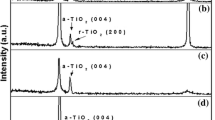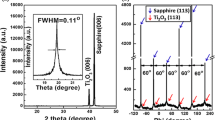Abstract
We have investigated the formation of the rutile and the anatase polymorphs of TiO2, with emphasis on epitaxial growth characteristics, and defect content as a function of laser and substrate variables. X-ray diffraction (XRD) studies revealed that the rutile phase is more stable at higher substrate temperatures and lower oxygen pressures; in contrast, decreasing the temperature and increasing the oxygen pressure gave rise to formation of anatase. Epitaxial rutile films with a <100> orientation were obtained at 450 °C using the pressure of 5 × 10-4 Torr, and laser energy of 3.5-4.0 J/cm2. The epitaxial relationship, determined by 2θ-θ and Φ scan of XRD and confirmed by transmission electron microscopy (TEM) diffraction patterns, was shown to be rutile(100)‖sapphire(0001), rutile[001]‖sapphire[1010] and rutile[010]‖sapphire[1210]. An atomically sharp interface between the rutile epitaxial film and the sapphire substrate was observed in the scanning transmission electron microscopy (STEM) images. The films exhibited a transmittance of 75-90% over the visible region. The absorption edge was observed to shift toward longer wave lengths at higher deposition temperatures or lower pressures. X-ray photoelectron spectroscopy and photoluminescence results showed that concentration of lattice point defects, namely oxygen vacancies and titanium interstitials, increased at lower oxygen pressures. Formation of nanostructured films with a surface roughness of -1.5-13.1 nm was confirmed by atomic force microscopy investigations.















Similar content being viewed by others
References
M.R. Bayati, A.Z. Moshfegh, and F. Golestani-Fard: On the photocatalytic activity of the sulfur doped titania nano-porous films derived via micro-arc oxidation. Appl. Catal., A 389, 60 (2010).
M.R. Bayati, F. Golestani-Fard, and A.Z. Moshfegh: In situ growth of vanadia-titania nano/micro-porous layers with enhanced photocatalytic performance by micro-arc oxidation. Electrochim. Acta 55, 3093 (2010).
M.R. Bayati, F. Golestani-Fard, and A.Z. Moshfegh: Visible photodecomposition of methylene blue over micro arc oxidized WO3-loaded TiO2 nano-porous layers. Appl. Catal., A 382, 322 (2010).
M.R. Bayati, F. Golestani-Fard, A.Z. Moshfegh, and R. Molaei: In situ derivation of sulfur activated TiO2 nano porous layers through pulse-micro arc oxidation technology. Mater. Res. Bull. 46, 531 (2011).
H. Park, W.R. Kim, H.T. Jeong, J.J. Lee, H.G. Kim, and W.Y. Choi: Fabrication of dye-sensitized solar cells by transplanting highly ordered TiO2 nanotube arrays. Sol. Energy Mater. Sol. Cells 95, 184 (2011).
J. Yu, Q. Li, and Z. Shu: Dye-sensitized solar cells based on double-layered TiO2 composite films and enhanced photovoltaic performance. Electrochim. Acta 56, 6293 (2011).
G.J. Yang, C.J. Li, S.Q. Fan, and J.C. Gao: Influence of pore structure on ion diffusion property in porous TiO2 coating and photovoltaic performance of dye-sensitized solar cells. Surf. Coat. Technol. 205, 3205 (2011).
C. Karunakaran, G. Abiramasundari, P. Gomathisankar, G. Manikandan, and V. Anandi: Preparation and characterization of ZnO-TiO2 nanocomposite for photocatalytic disinfection of bacteria and detoxification of cyanide under visible light. Mater. Res. Bull. 46, 1586 (2011).
B.S. Necula, I. Apachitei, F.D. Tichelaar, L.E. Fratila-Apachitei, and J. Duszczyk: An electron microscopical study on the growth of TiO2-Ag antibacterial coatings on Ti6Al7Nb biomedical alloy. Acta Biomater. 7, 2751 (2011).
M.R. Bayati and R. Molaei: Visible photoinduced hydrophilicity of V2O5-TiO2 nanoporous ceramic layers grown via micro-arc oxidation. J. Phys. D: Appl. Phys. 43, 505304 (2010).
K.X. Zhang, W. Wang, J.L. Hou, J.H. Zhao, Y. Zhang, and Y.C. Fang: Oxygen plasma induced hydrophilicity of TiO2 thin films. Vacuum 85, 990 (2011).
M.R. Bayati, R. Molaei, A. Kajbafvala, S. Zanganeh, H.R. Zargar, and K. Janghorban: Investigation on hydrophilicity of micro-arc oxidized TiO2 nano/micro-porous layers. Electrochim. Acta 55, 5786 (2010).
J. Moon, J. Park, S.J. Lee, T. Zyung, and I.D. Kim: Pd-doped TiO2 nanofiber networks for gas sensor applications. Sens. Actuators, B 149, 301 (2010).
S. Lin, D. Li, J. Wu, X. Li, and S.A. Akbar: A selective room temperature formaldehyde gas sensor using TiO2 nanotube arrays. Sens. Actuators, B 156, 505 (2011).
C. Han, D. Hong, S. Han, J. Gwak, and K. Singh: Catalytic combustion type hydrogen gas sensor using TiO2 and UV-LED. Sens. Actuators, B 125, 224 (2007).
A.A. Ashkarran, S.M. Aghigh, M. Kavianipour, and N.J. Farahani: Visible light photo-and bioactivity of Ag/TiO2 nanocomposite with various silver contents. Curr. Appl. Phys. 11, 1048 (2011).
R. Khan and M. Dhayal: Nanocrystalline bioactive TiO2-chitosan impedimetric immunosensor for ochratoxin-A. Electrochem. Commun. 10, 492 (2008).
K. Fröhlich, B. Hudec, J. Aarik, A. Tarre, D. Machajdík, A. Kasikov, K. Hušeková, and Š. Gaži: Post-deposition processing and oxygen content of TiO2-based capacitors. Microelectron. Eng. 88, 1525 (2011).
B. Hudec, K. Hušeková, A. Tarre, J.H. Han, S. Han, A. Rosová, W. Lee, A. Kasikov, S.J. Song, J. Aarik, C.S. Hwang, and K. Fröhlich: Electrical properties of TiO2-based MIM capacitors deposited by TiCl4 and TTIP based atomic layer deposition processes. Microelectron. Eng. 88, 1514 (2011).
M. Popovici, M.S. Kim, K. Tomida, J. Swerts, H. Tielens, A. Moussa, O. Richard, H. Bender, A. Franquet, T. Conard, L. Altimime, S.V. Elshocht, and J.A. Kittl: Improved EOT and leakage current for metal-insulator-metal capacitor stacks with rutile TiO2. Microelectron. Eng. 88, 1517 (2011).
B.B. Topuz, G. Gündüz, B. Mavis, and Ü. Çolak: The effect of tin dioxide (SnO2) on the anatase-rutile phase transformation of titania (TiO2) in mica-titania pigments and their use in paint. Dyes Pigm. 90, 123 (2011).
M.R. Mahmoudian, W.J. Basirun, Y. Alias, and M. Ebadi: Synthesis and characterization of polypyrrole/Sn-doped TiO2 nanocomposites (NCs) as a protective pigment. Appl. Surf. Sci. 257, 8317 (2011).
M.R. Bayati, A.Z. Moshfegh, and F. Golestani-Fard: Micro-arc oxidized S-TiO2 nanoporous layers: Cationic or anionic doping?Mater. Lett. 64, 2215 (2010).
A. Fujishima, X. Zhang, and D.A. Tryk: TiO2 photocatalysis and related surface phenomena. Surf. Sci. Rep. 63, 515 (2008).
N. Sbai, J. Perriere, W. Seiler, and E. Millon: Epitaxial growth of titanium oxide thin films on c-cut and a-cut sapphire substrates. Surf. Sci. 601, 5649 (2007).
J.F. Banfield, D.R. Veblen, and D.J. Smith: Conversion of perovskite to anatase and TiO2 (B): A TEM study and the use of fundamental building blocks for understanding relationships among the TiO, minerals. Am. Mineral. 76, 343 (1991).
C.T. Dervos, E. Thirios, J. Novacovich, P. Vassiliou, and P. Skafidas: Permittivity properties of thermally treated TiO2. Mater. Lett. 58, 1502 (2004).
G. Madras, B.J. McCoy, and A. Navrotsky: Kinetic model for TiO2 polymorphic transformation from anatase to rutile. J. Am. Ceram. Soc. 90, 250 (2007).
R. Sanjines, H. Tang, H. Berger, F. Gozzo, G. Margaritondo, and F. Levy: Electronic structure of anatase TiO2 oxide. J. Appl. Phys. 75, 2945 (1994).
J.C. Auger, B. Stout, R.G. Barrera, and F. Curiel: Scattering properties of rutile pigments located eccentrically within microvoids. J. Quant. Spectrosc. Radiat. Transfer 70, 675 (2001).
M. Cernea, M. Secu, C.E. Secu, M. Baibarac, and B.S. Vasile: Structural and thermoluminescence properties of undoped and Fe-doped-TiO2 nanopowders processed by sol-gel method. J. Nanopart. Res. 13, 77 (2011).
M. Andersson, A. Kiselev, L. Osterlund, and A.E.C. Palmqvist: Microemulsion-mediated room-temperature synthesis of high-surface-area rutile and its photocatalytic performance. J. Phys. Chem. C 111, 6789 (2007).
S.K. Kim, S.W. Lee, J.H. Han, B. Lee, S. Han, and C.S. Hwang: Capacitors with an equivalent oxide thickness of <0.5 nm for nanoscale electronic semiconductor memory. Adv. Funct. Mater. 20, 2989 (2010).
U. Diebold: The surface science of titanium dioxide. Surf. Sci. Rep. 48, 53 (2003).
A. Fujishima and K. Honda: Electrochemical photolysis of water at a semiconductor electrode. Nature 238, 37 (1972).
D. Yoo, I. Kim, S. Kim, C. Hahn, C. Lee, and S. Cho: Effects of annealing temperature and method on structural and optical properties of TiO2 films prepared by RF magnetron sputtering at room temperature. Appl. Surf. Sci. 253, 3888 (2007).
Y.Q. Hou, D.M. Zhuang, G. Zhang, M. Zhao, and M.S. Wu: Influence of annealing temperature on the properties of titanium oxide thin film. Appl. Surf. Sci. 218, 97 (2003).
S. Chen, M.G. Mason, H.J. Gysling, G.R. Paz-Pujalt, T.N. Blanton, T. Castro. K.M. Chen, C.P. Fictorie, W.L. Gladfelter, A. Franciosi, P.I. Cohen, and J.F. Evans: Ultrahigh vacuum metalorganic chemical vapor deposition growth and in situ characterization of epitaxial TiO2 films. J. Vac. Sci. Technol., A 11, 2419 (1993).
Y. Gao, S. Thevuthasan, D.E. McCready, and M. Engelhard: MOCVD growth and structure of Nb- and V-doped TiO2 films on sapphire. J. Cryst. Growth 212, 178 (2000).
R.K. Singh and J. Narayan: Pulsed-laser evaporation technique for deposition of thin films: Physics and theoretical model. Phys. Rev. B 41, 8843 (1990).
D.G. Syarif, A. Miyashita, T. Yamaki, T. Sumita, Y. Choi, and H. Itoh: Preparation of anatase and rutile thin films by controlling oxygen partial pressure. Appl. Surf. Sci. 193, 287 (2002).
H. Long, G. Yang, A. Chen, Y. Li, and P. Lu: Growth and characteristics of laser deposited anatase and rutile TiO2 films on Si substrates. Thin Solid Films 517, 745 (2008).
S.D. Mo and W.Y. Ching: Electronic and optical properties of three phases of titanium dioxide: Rutile, anatase, and brookite. Phys. Rev. B 51, 13023 (1995).
S. Na-Phattalung, M.F. Smith, K. Kim, M.H. Du, and S.H. Wei: First-principles study of native defects in anatase TiO2. Phys. Rev. B 73, 125205 (2006).
S.W. Chan: Degenerate epitaxy, coincidence epitaxy and origin of “special” boundaries in thin films. J. Phys. Chem. Solids 55, 1137 (1994).
H. Zhou, M.F. Chisholm, T.H. Yang, S.J. Pennycook, and J. Narayan: Role of interfacial transition layers in VO2/Al2O3 heterostructures. J. Appl. Phys. 110, 073515 (2011).
M.R. Bayati, R. Molaei, R.J. Narayan, J. Narayan, H. Zhou, and S.J. Pennycook: Domain epitaxy in TiO2/a-Al2O3 thin film heterostructures with Ti2O3 transient layer. Appl. Phys. Lett. 100, 251606 (2012).
M.A. Afifi, M.M. Abdel-Aziz, I.S. Yahia, M. Fadel, and L.A. Wahab: Transport properties of polycrystalline TiO2 and Ti2O3 as semiconducting oxides. J. Alloys Compd. 455, 92 (2008).
J. Narayan and B.C. Larson: Domain epitaxy: A unified paradigm for thin film growth. J. Appl. Phys. 93, 278 (2003).
S. Mal, S. Nori, C.M. Jin, J. Narayan, S. Nellutla, A.I. Smirnov, and J.T. Prater: Reversible room temperature ferromagnetism in undoped zinc oxide: Correlation between defects and physical properties. J. Appl. Phys. 108, 073510 (2010).
E. Finazzi, C.D. Valentin, and G. Pacchioni: Nature of Ti Interstitials in reduced bulk anatase and rutile TiO2. J. Phys. Chem. C 113, 3382 (2009).
F.A. Kroger: The Chemistry of Imperfect Crystals (North Holland, Amsterdam, The Netherlands, 1974).
M.K. Nowotny, T. Bak, and J. Nowotny: Electrical properties and defect chemistry of TiO2 single crystal. I. Electrical conductivity. J. Phys. Chem. B 110, 16270 (2006).
M.K. Nowotny, L.R. Sheppard, T. Bak, and J. Nowotny: Defect chemistry of titanium dioxide. Application of defect engineering in processing of TiO2-based photocatalysts. J. Phys. Chem. C 112, 5275 (2008).
T. Bak, J. Nowotny, M. Rekas, and C.C. Sorrell: Defect chemistry and semiconducting properties of titanium dioxide: II. Defect diagrams. J. Phys. Chem. Solids 64, 1057 (2003).
K.V. Baiju, A. Zachariah, S. Shukla, S. Biju, M.L.P. Reddy, and K.G.K. Warrier: Correlating photoluminescence and photocatalytic activity of mixed-phase nanocrystalline titania. Catal. Lett. 130, 130 (2009).
Y. Cong, J. Zhang, F. Chen, and M. Anpo: Synthesis and characterization of nitrogen-doped TiO2 nanophotocatalyst with high visible light activity. J. Phys. Chem. C 111, 6976 (2007).
Acknowledgments
The financial support of the U.S. National Science Foundation (Grant No. 0803663) is highly appreciated.
Author information
Authors and Affiliations
Corresponding author
Additional information
This author was an editor of this focus issue during the review and decision stage. For the JMR policy on review and publication of manuscripts authored by editors, please refer to http://www.mrs.org/jmr-editor-manuscripts/
Rights and permissions
About this article
Cite this article
Bayati, M.R., Joshi, S., Narayan, R.J. et al. Low-temperature processing and control of structure and properties of TiO2/c-sapphire epitaxial heterostructures. Journal of Materials Research 28, 1669–1679 (2013). https://doi.org/10.1557/jmr.2013.42
Received:
Accepted:
Published:
Issue Date:
DOI: https://doi.org/10.1557/jmr.2013.42




